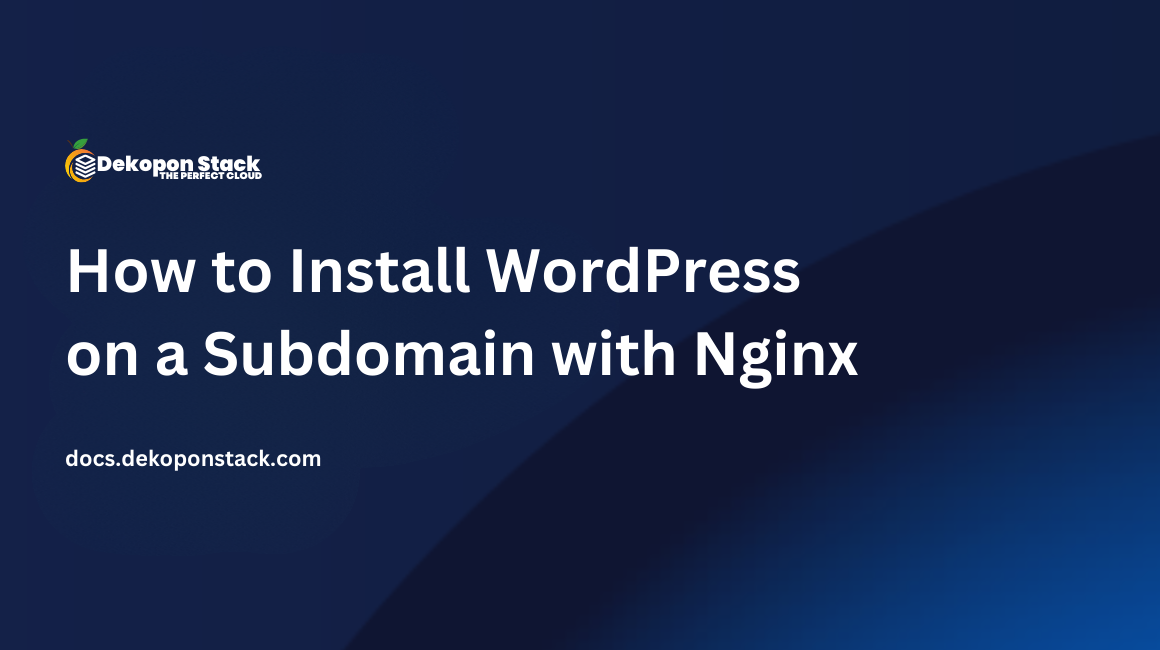
WordPress is a popular self-hosted Content Management System (CMS) commonly used to power blogs and general-purpose websites. Building a fast and reliable WordPress website requires a stable web server like Nginx to serve all necessary files requested by the website visitors on a specific domain.
With Nginx set up as the web server and MySQL or MariaDB as the database server, this article explains how to install WordPress on a subdomain and configure it to work well with the underlying infrastructure.
Before you begin, be sure to:
In this article, the subdomain
wp.example.comappears for demonstration purposes, be sure to replace all occurrences with your actual subdomain.
Log in to the MySQL database server.
$ mysql -u root -pCreate a new database.
mysql> CREATE DATABASE wp;Create a new database user secured with a strong password.
mysql> CREATE USER `wpuser`@`localhost` IDENTIFIED BY ‘Strong-Password’;Grant full privileges to the user in the WordPress database.
mysql> GRANT ALL PRIVILEGES ON wp.* TO 'wpuser’@’localhost';Refresh MySQL privileges.
mysql> FLUSH PRIVILEGESExit the MySQL console.
mysql> EXITCreate a new WordPress files directory.
$ sudo mkdir /var/www/wp.example.comDownload the latest WordPress release file.
$ wget http://wordpress.org/latest.tar.gzExtract files from the archive.
$ tar -xzf latest.tar.gzMove extracted files to the WordPress directory.
$ sudo mv wordpress/* /var/www/wp.example.comGrant Nginx read and write privileges to the directory.
$ sudo chown -R www-data:www-data /var/www/wp.example.comCreate a new Nginx Server Block in the /etc/nginx/sites-available directory.
$ sudo touch /etc/nginx/sites-available/wp.example.com.confUsing a text editor of your choice, edit the server block file.
$ sudo nano /etc/nginx/sites-available/wp.example.com.confCopy and paste the following configuration lines to the file.
fastcgi_cache_path /etc/nginx/cache levels=1:2 keys_zone=WP:100m inactive=60m;
fastcgi_cache_key "$scheme$request_method$host$request_uri";
server {
listen 80;
root /var/www/wp.example.com;
index index.php index.html index.htm;
server_name wp.example.com;
location = /favicon.ico {
log_not_found off;
access_log off;
expires max;
}
location = /robots.txt {
allow all;
log_not_found off;
access_log off;
}
location / {
# try_files $uri $uri/ =404;
try_files $uri $uri/ /index.php?q=$uri&$args;
}
location ~ \.php$ {
try_files $uri =404;
fastcgi_split_path_info ^(.+\.php)(/.+)$;
fastcgi_pass unix:/var/run/php/php7.4-fpm.sock;
fastcgi_index index.php;
fastcgi_param SCRIPT_FILENAME $document_root$fastcgi_script_name;
include fastcgi_params;
# Enable FastCGI Caching
fastcgi_cache WP;
fastcgi_cache_valid 200 60m;
}
}Save and close the file.
The configuration file includes FastCGI Caching and PHP settings for the WordPress website.
Test Nginx for configuration errors.
$ sudo nginx -tActivate the Nginx server block by linking it to the /etc/nginx/sites-enabled directory.
$ sudo ln -s /etc/nginx/sites-available/wp.example.com.conf /etc/nginx/sites-enabled/wp.example.com.confRestart Nginx for changes to take effect.
$ sudo systemctl nginx restartStart PHP-FPM to serve WordPress PHP files.
$ sudo systemctl php7.4-fpm startAllow the HTTP and HTTPS ports through the firewall.
On Debian-based systems with UFW:
$ sudo ufw allow 80/tcp
$ sudo ufw allow 443/tcpOn RHEL-based systems with FirewallD:
$ sudo firewall-cmd --permanent --zone=public --add-service=http.
$ sudo firewall-cmd --permanent --zone=public --add-service=https.Install Certbot to secure the WordPress site with HTTPS.
On Debian-based systems:
$ sudo apt install certbot python3-certbot-nginxOn RHEL-based systems:
$ sudo yum install certbot python3-certbot-nginxUse Certbot to request a free Let's Encrypt SSL Certificate.
$ sudo certbot -d wp.example.com -d www.wp.example.comEdit the Nginx server block file.
$ sudo nano /etc/nginx/sites-available/wp.example.com.confAdd the following lines in the server{ section to redirect all HTTP requests to HTTPS and also restrict access to critical website files such as .php and .htaccess.
# Redirect all HTTP requests to HTTPS
return 301 https://wp.example.com$request_uri;
# Deny access to hidden files such as .htaccess
location ~ /\. {
deny all;
access_log off;
log_not_found off;
}
# Deny access to any PHP files In the WordPress uploads directory
location /wp-content/uploads/ {
location ~ \.php$ {
deny all;
}
}Start a new web browser session on your local computer and visit your configured subdomain.
http://wp.example.comYou have successfully installed WordPress on a subdomain with Nginx, for further information on how to use WordPress and Nginx, refer to the following resources: